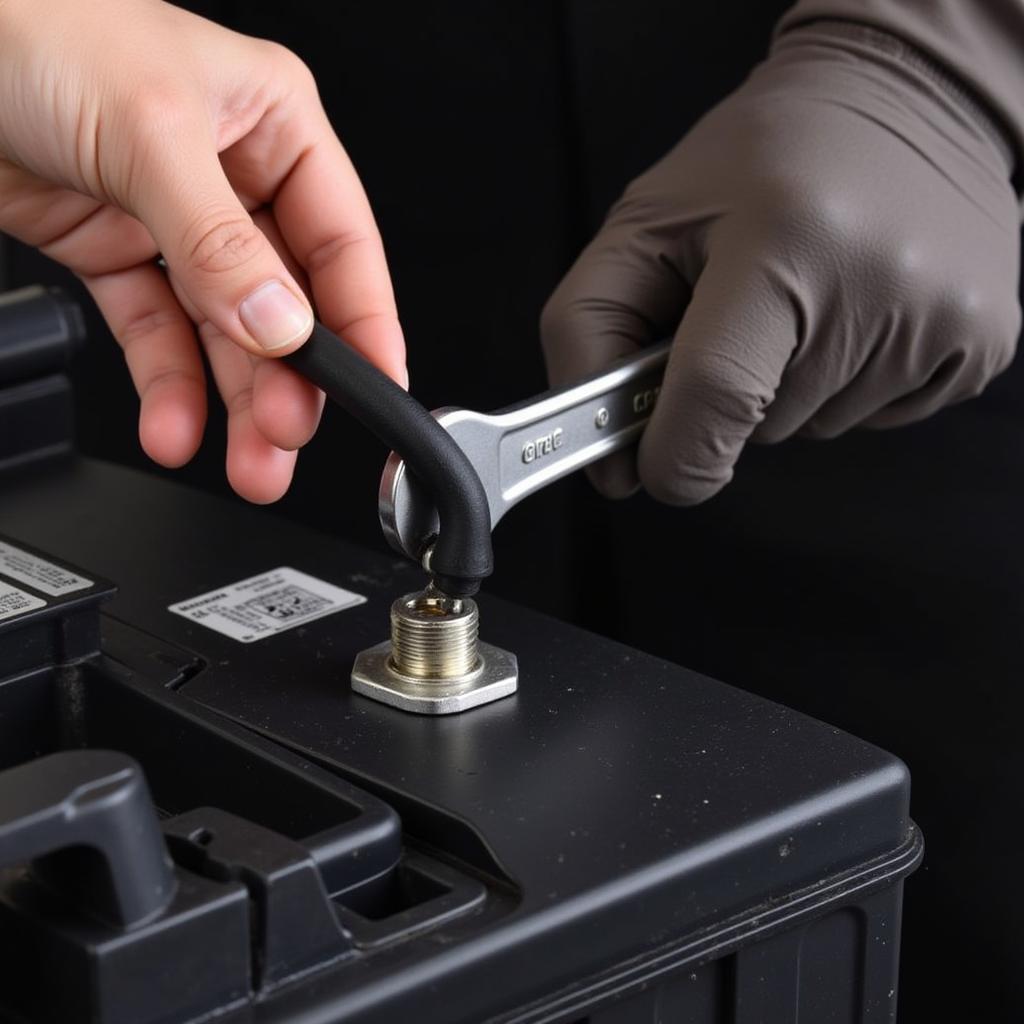Changing your car battery might seem daunting, but with the right tools and a little know-how, it’s a task most car owners can tackle themselves. This guide will walk you through exactly what tools you need to change your car battery, ensuring a safe and successful swap. Let’s get started!
Gathering Your Battery Changing Arsenal
Before you even pop the hood, gathering the necessary tools will make the process much smoother. Having everything at hand prevents interruptions and ensures you’re prepared for any hiccups along the way.
Essential Tools for a Smooth Battery Change
- Wrench (usually 10mm or 13mm): This is the workhorse of the operation. You’ll use it to loosen and tighten the battery terminals. Make sure you have the correct size for your specific vehicle. Sometimes, you might need an extension for better leverage.
- Gloves: Battery acid is corrosive, so protecting your hands is paramount. Use a pair of sturdy work gloves or even dishwashing gloves in a pinch.
- Safety Glasses: While rare, battery acid can splash. Protecting your eyes is a simple precaution that can prevent serious injury.
- Battery Terminal Cleaner: This handy tool helps remove corrosion from the battery terminals and ensures a good connection. A wire brush can also work effectively.
- New Battery: This might seem obvious, but double-check that you have the correct battery for your car’s make and model.
- Rags or Paper Towels: For cleaning up any spilled battery acid or general grime.
- Battery Terminal Protector (optional): Applying this to the terminals after installation prevents future corrosion.
Step-by-Step Guide to Changing Your Car Battery
Now that you have your tools assembled, let’s dive into the process. Remember to consult your car’s owner’s manual for specific instructions related to your vehicle.
- Park on a Level Surface: Safety first! Ensure your car is parked on a level surface and the engine is off.
- Locate the Battery: Usually under the hood, but sometimes in the trunk or even under the back seat. Refer to your owner’s manual if you’re unsure.
- Disconnect the Negative Terminal: Using your wrench, loosen the nut on the negative terminal (marked with a “-” symbol) and carefully remove the cable.
- Disconnect the Positive Terminal: Repeat the process for the positive terminal (marked with a “+” symbol).
- Remove the Battery Hold-Down: There’s usually a clamp or bracket securing the battery. Remove it using the appropriate tool, often the same wrench.
- Lift Out the Old Battery: Carefully lift the old battery out of the tray, keeping it upright to avoid spilling any acid.
- Clean the Terminals: Use your battery terminal cleaner or wire brush to remove any corrosion from the terminals and cable connectors.
- Install the New Battery: Place the new battery in the tray, ensuring it’s oriented correctly.
- Connect the Positive Terminal: Attach the positive cable to the positive terminal and tighten the nut.
- Connect the Negative Terminal: Attach the negative cable to the negative terminal and tighten the nut.
- Secure the Battery: Reinstall the hold-down clamp or bracket.
- Apply Terminal Protector (optional): Apply the protector to the terminals to prevent corrosion.
 Connecting Car Battery Terminals
Connecting Car Battery Terminals
Expert Insights on Battery Changes
John Smith, a seasoned automotive technician with over 20 years of experience, emphasizes the importance of safety: “Always wear gloves and eye protection when working with car batteries. Battery acid can cause serious burns.” He also recommends using a memory saver to prevent losing your radio presets and other electronic settings.
Jane Doe, an electrical engineer specializing in automotive systems, adds, “Choosing the right battery for your vehicle is crucial. Consider factors like climate and driving habits. A battery designed for extreme temperatures might be necessary if you live in a very hot or cold climate.”
Conclusion
Changing your car battery is a manageable DIY project with the right tools and knowledge. By following this guide, you can save money and gain a better understanding of your vehicle. Remember to always prioritize safety and consult your owner’s manual for specific instructions related to your car model. Now you’re equipped to tackle this task with confidence! Don’t forget to check out our articles on tools to service a car and tool for cars for more helpful information on car maintenance.
FAQs
- How often should I change my car battery? Typically, every 3-5 years.
- Can I jump-start my car with a dead battery? Yes, using jumper cables and another vehicle with a working battery.
- What are the signs of a failing car battery? Slow engine cranking, dimming headlights, and electrical issues.
- How do I dispose of an old car battery? Take it to a recycling center or auto parts store.
- What causes car battery corrosion? Exposure to moisture, heat, and battery acid fumes.
Other Common Scenarios
- Battery light on dashboard: This indicates a problem with the charging system, not necessarily a bad battery.
- Clicking sound when turning the key: Could be a dead battery or a starter issue.
More Helpful Resources
Check out our articles on download carly pro scan tools and hyundai tool box in car for further insights into car diagnostics and tools. Also, explore car radio removal tool amazon for specialized tools.
Need further assistance? Contact us via WhatsApp: +1(641)206-8880, Email: [email protected] or visit us at 910 Cedar Lane, Chicago, IL 60605, USA. Our customer support team is available 24/7.

Leave a Reply